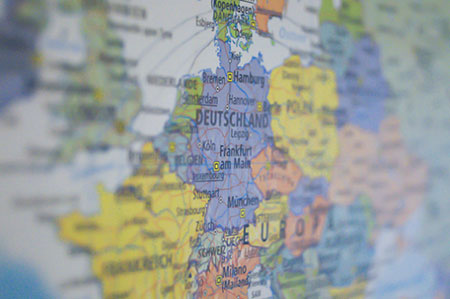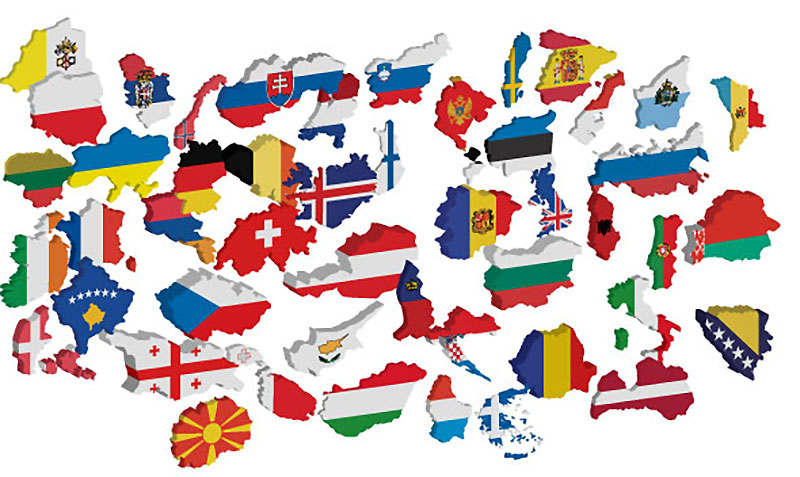Countries of Europe
The United Nations officially recognizes 44 countries in Europe. Below we have a table which shows a full list of the countries and the capital cities of Europe in population order. There are a few countries that did not make the list that possibly could have. These being Georgia, Armenia. Until recently Turkey was looking like a candidate to at least become part of the EU if not a part of Europe proper. In 2019 when this article was written that prospect is looking a lot less likely.
 There are 4 dependant territories that aren’t listed below, They are the Channel Islands, Gibraltar, Faeroe Islands and the Isle of Man. The other Country that is not listed is Cyprus. It has a special position as it spans both Europe and Asia with one half being Greek and the other half being Turkish. The territories are still under dispute since the Turkish invasion of the island in 1974.
There are 4 dependant territories that aren’t listed below, They are the Channel Islands, Gibraltar, Faeroe Islands and the Isle of Man. The other Country that is not listed is Cyprus. It has a special position as it spans both Europe and Asia with one half being Greek and the other half being Turkish. The territories are still under dispute since the Turkish invasion of the island in 1974.
To see how they all the countries fit together go to our latest political map of Europe. This map will show all the countries listed below but will also show the countries that are missing from the list as per the explanation above. In future articles we will be splitting up the countries of Europe into their separate regions. These being Southern Europe, Norther Europe, Eastern Europe and Western Europe.
| Russia | 143,895,551 | Moscow |
| Germany | 82,438,639 | Berlin |
| United Kingdom |
66,959,016 | London |
| France | 65,480,710 | Paris |
| Italy | 59,216,525 | Rome |
| Spain | 46,441,049 | Madrid |
| Ukraine | 43,795,220 | Kyiv (also known as Kiev) |
| Poland | 38,028,278 | Warsaw |
| Romania | 19,483,360 | Bucharest |
| Netherlands | 17,132,908 | Amsterdam |
| Belgium | 11,562,784 | Brussels |
| Greece | 11,124,603 | Athens |
| Czech Republic |
10,630,589 | Prague |
| Portugal | 10,254,666 | Lisbon |
| Sweden | 10,053,135 | Stockholm |
| Hungary | 9,655,361 | Budapest |
| Belarus | 9,433,874 | Minsk |
| Austria | 8,766,201 | Vienna |
| Serbia | 8,733,407 | Belgrade |
| Switzerland | 8,608,259 | Bern |
| Bulgaria | 6,988,739 | Sofia |
| Denmark | 5,775,224 | Copenhagen |
| Finland | 5,561,389 | Helsinki |
| Slovakia | 5,450,987 | Bratislava |
| Norway | 5,400,916 | Oslo |
| Ireland | 4,847,139 | Dublin |
| Croatia | 4,140,148 | Zagreb |
| Moldova | 4,029,750 | Chisinau |
| Bosnia and Herzegovina |
3,501,774 | Sarajevo |
| Albania | 2,938,428 | Tirana |
| Lithuania | 2,864,459 | Vilnius |
| North Macedonia | 2,086,720 | (FYROM) Skopje |
| Slovenia | 2,081,900 | Ljubljana |
| Latvia | 1,911,108 | Riga |
| Estonia | 1,303,798 | Tallinn |
| Montenegro | 629,355 | Podgorica |
| Luxembourg | 596,992 | Luxembourg (city) |
| Malta | 433,245 | Valletta |
| Iceland | 340,566 | Reykjavik |
| Andorra | 77,072 | Andorra la Vella |
| Monaco | 39,102 | Monaco |
| Liechtenstein | 38,404 | Vaduz |
| San Marino | 33,683 | San Marino |
| Holy See | 799 | Vatican City |
Through out history the countries of Europe has been very changeable and fluid. There have been times when there have been as few as 16 countries. In the past the Ottoman Turks had taken huge swathes of Europe and formulated them into one country. Although those countries were under a Turkish/Asian empire they were still technically considered part of Europe. The Austro-Hungarian empire also consolidated large parts of Europe into one political entity. Although Europe has been relatively stable of late borders are always fluid. A good example of this is what is happening with the “Brexit” debate in the EU. Borders will have to once again be redrawn as the Irish republic stays in the EU but NortherN Ireland leaves. Stay tuned to MapofEurope.com to keep you up to date.

